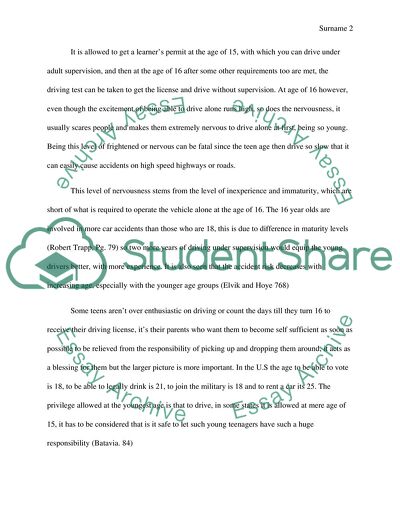
- Home
- Free Samples
- Premium Essays
- Editing Services
- Extra Tools
- Essay Writing Help
- About Us
- Studentshare
- Subjects
- Miscellaneous
- Based on the quote, research this topic and persuade the reader, whether you agree or not, that it's in the best interest of the country to raise the national driving age to 18 years
Based on the quote, research this topic and persuade the reader, whether you agree or not, that it's in the best interest of the country to raise the national driving age to 18 years - Essay Example

- Subject: Miscellaneous
- Type: Essay
- Level: Masters
- Pages: 4 (1000 words)
- Downloads: 0
- Author: rfranecki
Extract of sample "Based on the quote, research this topic and persuade the reader, whether you agree or not, that it's in the best interest of the country to raise the national driving age to 18 years"
It is said that in most of the families, both the parents have jobs and thus, are not able to pick and drop their teens to jobs, functions etc. so with the teenagers being able to obtain a license and drive, it lessens the burden off parents. This argument is not too solid, as saving lives is more essential than economic benefits of a small age group. Also, the poor families are not likely to be affected by this much anyway, since they can’t afford enough vehicles for the kids too and would use public transportation regardless (Trapp 79) It is allowed to get a learner’s permit at the age of 15, with which you can drive under adult supervision, and then at the age of 16 after some other requirements too are met, the driving test can be taken to get the license and drive without supervision.
At age of 16 however, even though the excitement of being able to drive alone runs high, so does the nervousness, it usually scares people and makes them extremely nervous to drive alone at first, being so young. Being this level of frightened or nervous can be fatal since the teen age then drive so slow that it can easily cause accidents on high speed highways or roads. This level of nervousness stems from the level of inexperience and immaturity, which are short of what is required to operate the vehicle alone at the age of 16.
The 16 year olds are involved in more car accidents than those who are 18, this is due to difference in maturity levels (Robert Trapp, Pg. 79) so two more years of driving under supervision would equip the young drivers better, with more experience. It is also seen that the accident risk decreases with increasing age, especially with the younger age groups (Elvik and Hoye 768) Some teens aren’t over enthusiastic on driving or count the days till they turn 16 to receive their driving license, it’s their
...Download file to see next pages Read MoreCHECK THESE SAMPLES OF Based on the quote, research this topic and persuade the reader, whether you agree or not, that it's in the best interest of the country to raise the national driving age to 18 years
Human Resource Management in International Organizations
EAL Educational Children Support
The effective of outdoor advertsing using exmaple from the mobile phone indusrty
Lower Alcohol age to 18
Minimum Legal Drinking Age
The State of Florida should raise the legal drivers age to 18
Kim Jong II and His Leadership
Trust, Self-Esteem and Volunteerism

- TERMS & CONDITIONS
- PRIVACY POLICY
- COOKIES POLICY